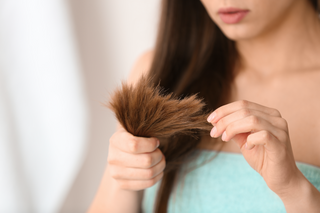Have you ever wondered why split ends happen? We’ve got the answer! Here’s the science behind split ends.
Split Ends By Any Other Name
Did you know there’s a medical term for split ends? It’s trichoptilosis. If we look at the etymology of the word, the prefix “trich” means hair, “ptil” means feather,” and “osis” means condition. So altogether, a condition of feathering hair–pretty accurate, no?
But let’s be real, these aren’t the kind of feathers you’d ask your stylist for (although you can always ask for your trichoptilosis to be treated at your next appointment!). Instead, the terminology refers to the way our hair splits apart, causing it to resemble a feather.
So what causes split ends? It’s time for an anatomy lesson.
The Anatomy of Your Hair
In order to understand split ends, you first need to understand the anatomy of your hair. Each strand of hair grows out of a follicle in your scalp. The strand is called the hair shaft, and it’s made up of three layers.
The deepest layer is the medulla, and it’s the layer that creates your hair color. The middle layer is the cortex. This is where your hair’s strength comes from. It’s made up of keratin, a type of protein. And finally, the outer layer is the cuticle. Think of it as having overlapping scales.
Split ends happen when those scales are damaged or unable to lie flat against each other. Without the protective cuticle, damage extends to the cortex, where the keratin comes apart, resulting in your hair splitting. That’s why keeping your cuticle intact is so important.
What Damages Your Cuticle?
Unfortunately, many of our hair care and styling choices can damage our cuticles. And so can environmental factors. Let’s look at a few.
- Wind
- Sun
- Indoor heat
- Hair dye
- Chemical treatments
- Brushing
- Elastics
- Blow drying
- Heat tools
- Chlorine
As you can see, your cuticle is pretty sensitive. And a lot of the things we do to our hair aren’t helping when it comes to preventing split ends.
So What Can You Do?
Now that you understand the science behind split ends, you can take steps to prevent them. It’s all about maintaining your hair’s health and your cuticle’s integrity.
Losing moisture is a big reason split ends occur. When our hair is dry, it’s also fragile. So space out your wash days to allow your natural oils to remain on your hair. And always follow shampoo with conditioner. It’s also a good idea to use a DIY mask once a week or so to add extra moisture to your hair.
Heat and chemicals can destroy your cuticle, so use them sparingly. Air dry your hair whenever you can. If you dye, relax, perm, or otherwise chemically treat your hair, be sure to give it plenty of extra TLC, since these treatments weaken your hair. And check out these no-heat styles if your hair needs a break from heat tools.
Finally, friction is another major source of damage to the cuticle, so do what you can to minimize it. Sleep on satin or silk pillowcases to prevent friction while you sleep. Avoid overly tight styles, and choose elastics that are covered in satin to avoid damaging your hair. And use a wide tooth comb to detangle your hair.
They say that understanding your enemy is the first step to defeating them. And now, you have all the knowledge you need to keep split ends at bay.
P.S. Already have split ends? Check out these tips to repair damage and breakage!

